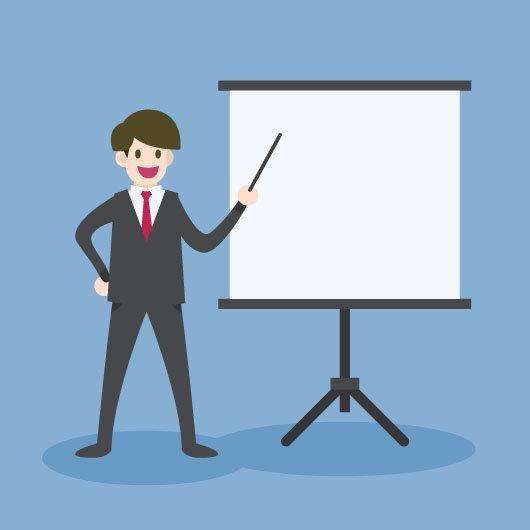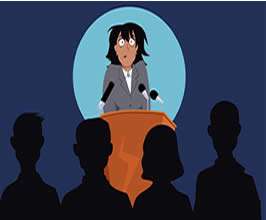If you've been called upon to give a presentation at a corporate event, meeting or special event, you've got a lot of planning and practicing ahead of you!
The ability to give an engaging and effective presentation is a true art form, and many people worry that their skills aren't up to par. If that is the case, getting help from outside will certainly assist you in many ways. But regardless of whether you attend a
course, study online, or get help from someone you know, there is still something that they're all going to want to know in order to help you best, and that's what kind of presentation you have to make.
Their guidance will be much more helpful if you can identify for them what kind of presentation it is, and what you hope to get out of it.
So, in order to start planning your talk and its' content (with or without help), it can help to consider the different reasons why people are often called to create and give performances in the first place.

Each presentation category has its own associated style, and as a result, its' own tips and tricks. It's important to understand this before you start planning your own presentation, because the reason for your talk will determine a whole host of factors. These include calls to action (CTAs), the use of humour, what visual aids you want to use, word choice, and pacing.
Read ahead to learn about the 7 main reasons why people give presentations, and get pointers about how you can improve each type. At some point in your life you'll likely have to do at least a few of these, so it pays to keep this information in mind.
1. Selling a product or service
The most common kind of presentation involves selling a specific product or service to a group of people. You are effectively "presenting" your product or service to them, hence the term presentation.
They may be familiar with your brand, or your company might be brand new to them. These are factors that will affect the way that you position the sale and the information that you include. For this presentation to be effective, you need to build trust, keep their attention, present the features and benefits, and close the sale. A strong and definitive CTA needs to be made at the end, either trying to close the sale or gain contact information for a follow-up.
You're also going to need to remember at what point of the sale process you're at with the prospective clients, as that will again determine which CTAs are applicable, and what you include.
2. Giving a toast at a party or celebration
Giving a toast can be a real honour, but you might find that your nerves are creeping up on you. Don't let anxiety get the best of you – focus on good memories, funny jokes, and heartfelt sentiments, all the while keeping thing short and sweet. While you don't need any kind of traditional CTA in a toast, you might consider the act of encouraging a swig of wine or beer the truest call to action at a wedding or party!

3. Teaching a new concept
Anyone who works in a teaching capacity will give this form of presentation regularly. Careers that include teaching presentations include: teachers, professors, professional trainers, tour guides, art historians, podcast hosts, news anchors and more.
If you are attempting to teach a group of people about a new concept, you need to first consider their motivation: are they listening to you of their own volition, or are they there as a requirement (i.e. for mandatory on the job training or as a part of a class)? If they're there of their own accord, it is much easier to keep their attention (they usually are wanting to be there precisely because they ARE interested); if their attendance is mandated, you'll have to work harder.
Visual aids (including photos, creative Powerpoint slides, videos and other media) can be a great help. You will likely not need a traditional CTA, but questions and fun exercises can help to keep everyone engaged.

If you'd like to learn more about delivering presentations, why not take a look at how we can help?
Boost your presentation skills with our online courses.
RRP from $65 – limited time offer just $23.99
4. Memorialising a loved one
Undeniably the saddest reason for a presentation, at times it is necessary to give a eulogy or toast to someone who has passed away. This can be one of the hardest presentations to give, as it often feels like there is a lot of pressure to be perfect and capture the deceased's essence. Focus on your own memories of your loved one, and speak from the heart. No CTA at all is needed here, although you can encourage everyone to keep the deceased on their mind and in their hearts.
5. Inspiring a crowd to take an action
"Ask not what your country can do for you—ask what you can do for your country." So goes the famous quote from legendary American president John F. Kennedy. His presentation was all about inspiring a crowd to take action, and he uses a very specific style of rhetoric to do so. Tugging on their heartstrings, calling to their best instincts, and reminding them of their shared ideals – all of these can be very effective ways to inspire a crowd of people.
At the end of this form of presentation, a strong and generalised CTA can be made (that will often be successful), inspiring people to be their best selves and work together for a common cause.

A final point on this one, is that this is generally the type of presentation or public speaking that draws attention, and they're the ones most likely to be famous. Think of all the great orators of the twentieth century, such as Kennedy, Winston Churchill and Dr Martin Luther King Jr. The speeches that they were famous for are all really this kind of presentation. You don't hear about their speeches to their graduation class, do you?
So if you ARE wanting to go down in history, these are the presentations that you have to nail! No "winging your way through it", these usually require far more time spent on precise wording, memorised exactly as is, to obtain the most effect.
6. Entertaining a group of people
One of the most fun and exciting forms of presentation, entertaining a group of people can be a truly artistic skill. After all, what is a stand-up comedian if not a presentation expert? You're just presenting yourself as the product!
Whether you're giving an amusing historical talk, telling jokes, telling stories, or reading fiction, entertaining a crowd can be very rewarding. A CTA can always be made at the end, encouraging the crowd to follow you on social media, attend more of your shows, or buy what you're selling,
7. Demonstrating that you understand a concept
In some cases, you will have to show a group of colleagues or an instructor that you understand a specific concept. This usually occurs when you are in a classroom or training setting, as you will often be assigned a topic that you must then research and expound upon. Perhaps this is solely to demonstrate that you understand the concept itself (you may be graded on it), and in other cases it is to engage in group learning and helping your peers to understand the subject matter as well. This style of presentation does not often need a CTA, but you may want to include questions (themselves a form of CTA) at the end in order to inspire further discussion.
No matter what kind of presentation you are giving, your style, cadence, vocabulary and CTA all need to be finely tailored to your audience. Keep the above points in mind, practice your talk, and break a leg!

If you'd like to learn more about delivering presentations, why not take a look at how we can help?
Boost your presentation skills with our online courses.
RRP from $65 – limited time offer just $23.99





























